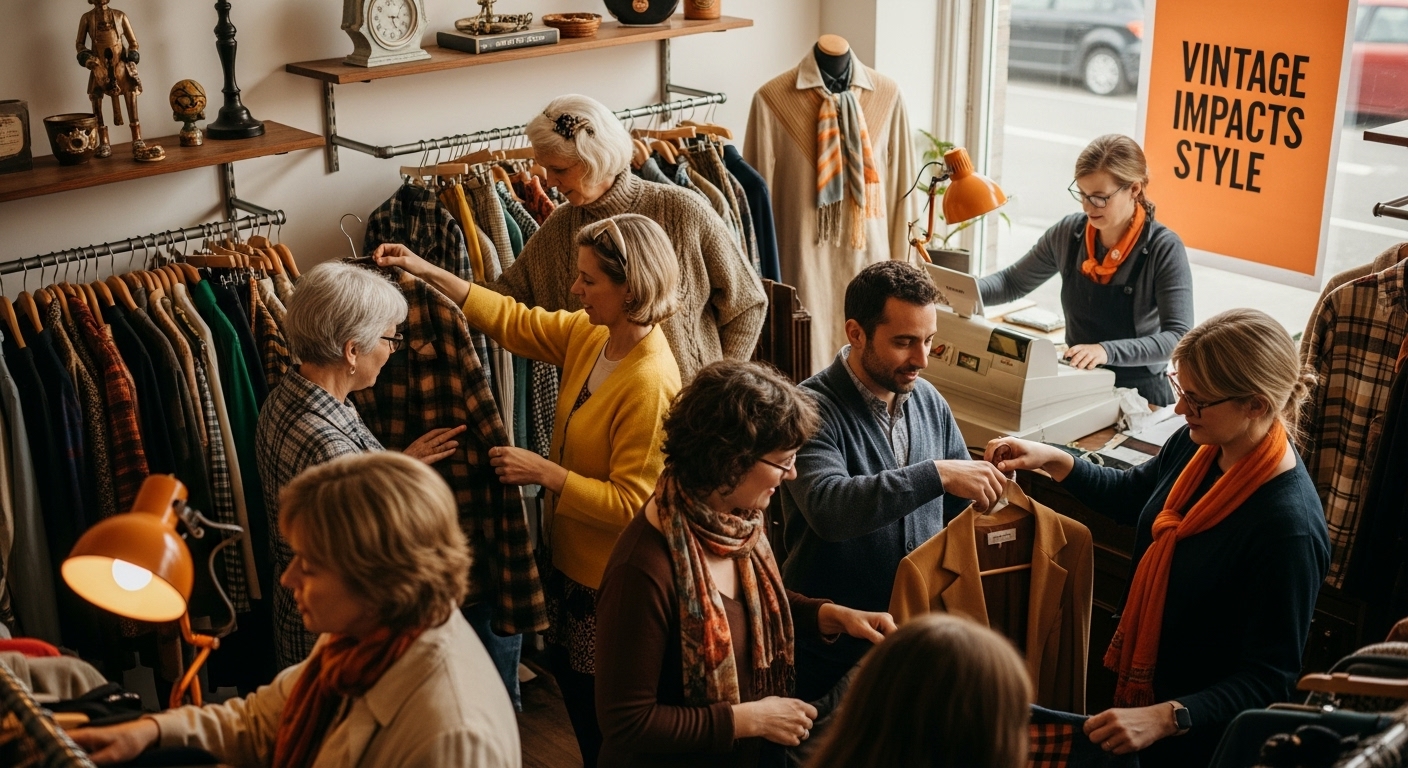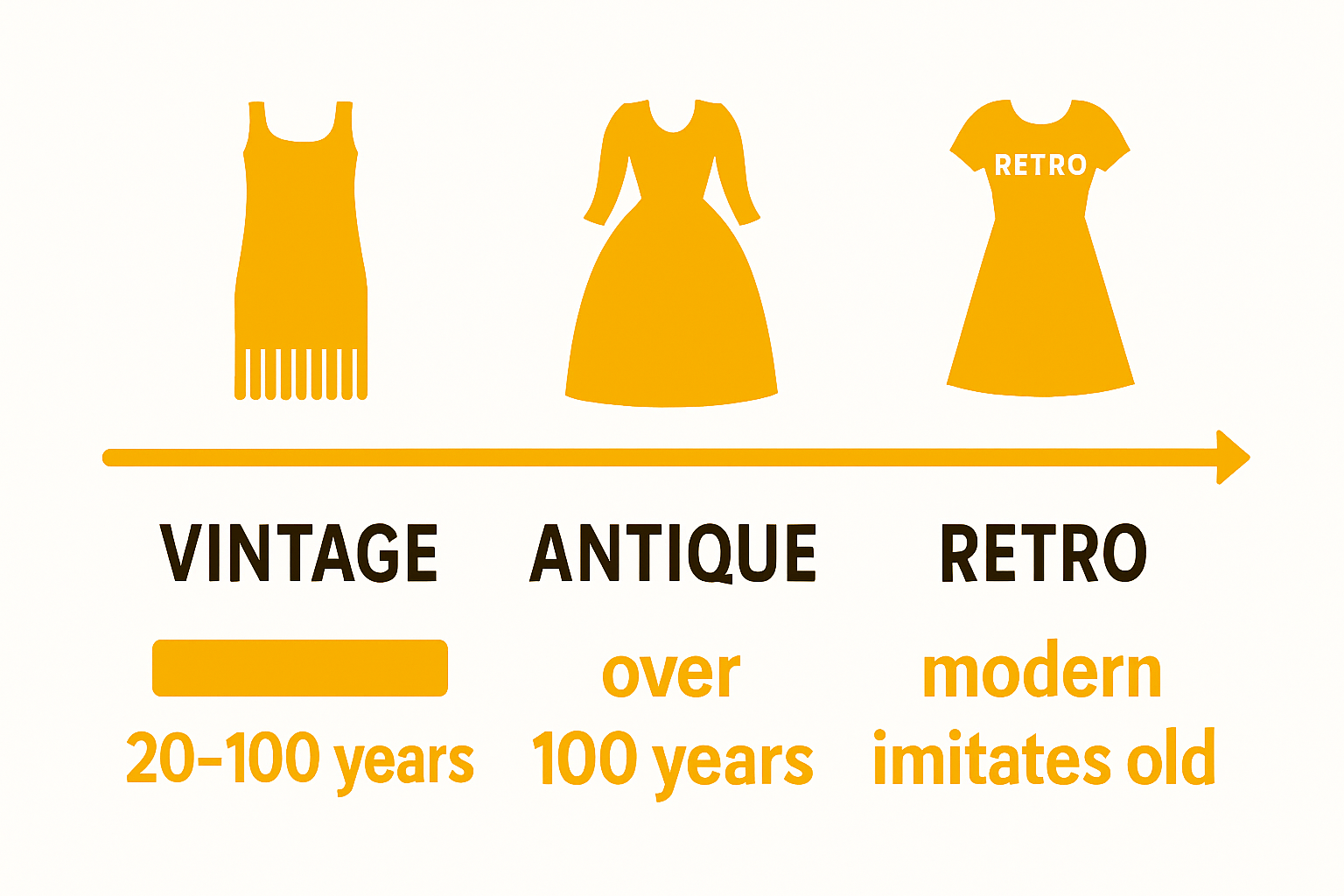Understanding How Vintage Impacts Style and Fashion Choices
- Emma

- Sep 16
- 7 min read

Vintage fashion is not just about second-hand clothes and quirky old styles. Turns out, true vintage is officially defined as any garment at least 20 years old, which means even pieces from the early 2000s now qualify. Yet what really surprises most people is that vintage is less about age and more about preserving history, craftsmanship, and unique self-expression all in one iconic look.
Table of Contents
How Vintage Impacts Style: Quick Summary
Takeaway | Explanation |
Vintage clothing is at least 20 years old. | Genuine vintage pieces capture authentic design aesthetics from historical periods, crucial for collectors and fashion historians. |
Understanding vintage categories helps collectors. | Distinguishing between vintage, antique, and retro enhances the appreciation of garments and their historical significance. |
Vintage fashion promotes personal expression. | Wearing vintage clothing allows individuals to showcase their creativity and unique sense of style through curated fashion choices. |
Vintage supports sustainability in fashion. | Choosing pre-existing garments contributes to reducing waste, highlighting the importance of ethical consumer behaviour against fast fashion. |
Vintage influences contemporary fashion designs. | Modern designers often draw inspiration from vintage styles, keeping historical aesthetics alive and integrated into current fashion trends. |
Defining Vintage: What Does It Mean in Fashion?
Vintage fashion represents far more than just old clothing. It embodies a nuanced understanding of historical style, craftsmanship, and cultural significance that transcends simple age categorisation. Genuine vintage pieces are typically defined as garments at least 20 years old, reflecting authentic design aesthetics from specific historical periods.
Historical Context and Age Classification
Understanding vintage requires recognising the precise distinctions between different classifications. Not every old garment qualifies as true vintage. Professional fashion historians and collectors typically use rigorous criteria:
Vintage: Clothing between 20-100 years old (e.g., pieces from 1920-2000)
Antique: Garments over 100 years old
Retro/Reproduction: Modern clothing mimicking historical styles
These classifications help enthusiasts and collectors distinguish authentic historical pieces from contemporary interpretations. Each category carries unique value and significance within fashion preservation and collecting communities.
Below is a table organising the key distinctions between vintage, antique, and retro/reproduction fashion categories, offering a clear reference for understanding these common terms.
Classification | Age Range | Description |
Vintage | 20-100 years old | Clothing pieces from specific historical periods, valued for authenticity and design. |
Antique | Over 100 years old | Garments considered historic relics, reflecting very early fashion eras. |
Retro/Reproduction | Modern, mimicking old styles | Contemporary items created to resemble or imitate earlier fashions. |

Cultural and Design Significance
Vintage fashion transcends mere clothing. It represents a living archive of social history, documenting design evolution, technological innovations in textile production, and changing cultural attitudes. Research from the Victoria and Albert Museum suggests vintage pieces offer profound insights into societal transformations, revealing how clothing reflects broader historical narratives.
Design enthusiasts and collectors can explore our comprehensive guide to vintage designers to understand the intricate world of historical fashion curation. Vintage items are not just garments but tangible connections to past creative expressions, embodying craftsmanship, individual artistic vision, and cultural zeitgeist.
The Significance of Vintage: Why It Matters in Style
Vintage fashion represents more than a trend; it is a profound cultural statement about personal expression, sustainability, and historical appreciation. Style enthusiasts increasingly recognise vintage clothing as a powerful medium for individual storytelling and environmental consciousness.
Personal Identity and Self-Expression
Choosing vintage clothing goes beyond aesthetic preferences. It represents a deliberate approach to personal styling that communicates unique narrative and individuality. Each vintage piece carries inherent historical context, allowing wearers to craft distinctive looks that transcend contemporary mass-produced fashion.
Key aspects of vintage fashion’s identity significance include:
Celebrating individual creativity
Rejecting standardised fashion norms
Connecting with historical design aesthetics
Expressing personality through curated clothing choices
Sustainability and Ethical Fashion
Research from the University of Huddersfield highlights vintage fashion as a critical component of sustainable consumer behaviour. By choosing pre-existing garments, fashion enthusiasts significantly reduce textile waste and minimise environmental impact. This approach challenges the fast fashion industry’s wasteful production models.
For those interested in exploring unique vintage pieces that embody both style and sustainability, our 1940s Horrockses Swirl Print Shirt Dress represents an exceptional example of historical craftsmanship and conscious fashion consumption.
Vintage fashion ultimately transcends mere clothing. It represents a holistic approach to personal style that values history, craftsmanship, environmental responsibility, and individual expression.
The table below summarises essential principles and impacts of vintage fashion, highlighting how it influences style, identity, sustainability, and contemporary trends.
Principle | Description |
Personal Identity & Self-Expression | Vintage pieces allow wearers to showcase individuality and creative personal style choices. |
Sustainability & Ethical Fashion | Choosing vintage supports waste reduction and cultivates ethical, environmentally conscious habits. |
Influence on Contemporary Trends | Vintage aesthetics are reinterpreted, inspiring modern designers in both runway and street fashion. |
Preservation of Heritage | Vintage garments maintain and celebrate craftsmanship, design integrity, and historical narratives. |

How Vintage Influences Contemporary Fashion Trends
Vintage fashion serves as a powerful catalyst for contemporary design innovation, continuously reshaping modern style narratives through historical reinterpretation. Contemporary designers and fashion houses increasingly draw inspiration from past decades, transforming nostalgic elements into cutting-edge fashion statements.
Cyclical Design Inspiration
Fashion operates in cyclical patterns, with trends repeatedly resurfacing and reinterpreting historical aesthetics. Each generation discovers and reimagines vintage styles, creating dynamic dialogues between past and present design philosophies. This continuous reinterpretation ensures that vintage remains a perpetual source of creative inspiration.
Key mechanisms of vintage influence include:
Direct design replication
Subtle aesthetic referencing
Modernising historical silhouettes
Incorporating vintage textile techniques
Runway and Street Style Integration
Research from the British Fashion Council demonstrates how vintage aesthetics profoundly impact contemporary fashion ecosystems. High-end designers and street style influencers alike frequently incorporate vintage-inspired elements, creating a multifaceted approach to modern fashion design.
For fashion enthusiasts seeking to explore vintage-inspired contemporary pieces, our Cute Black Pom Pom Fitted Top represents an excellent example of modern design influenced by historical fashion sensibilities.
Ultimately, vintage fashion transcends mere historical recreation. It represents a dynamic, ongoing conversation between past creativity and contemporary style innovation.
Key Concepts of Vintage Style: Timeless Aesthetics and Culture
Vintage style transcends mere clothing selection, representing a profound cultural dialogue between historical design principles and contemporary aesthetic sensibilities. It encompasses a rich tapestry of design philosophy, craftsmanship, and historical narrative that extends far beyond superficial fashion trends.
Aesthetic Philosophy and Heritage
Vintage style is fundamentally about understanding and appreciating design legacies. Each garment tells a complex story of cultural context, technological capabilities, and societal norms of its originating era. Authentic vintage pieces capture the essence of their historical moment, presenting a tangible connection to past creative expressions.
Critical aesthetic principles of vintage style include:
Celebrating original craftsmanship
Respecting historical design integrity
Understanding contextual fashion evolution
Recognising unique material and construction techniques
Cultural Preservation and Narrative
Research from the University of Arts London highlights vintage fashion as a critical mechanism for cultural memory preservation. Vintage clothing serves not just as wearable art but as a living archive documenting societal transformations, technological innovations, and artistic movements.
For enthusiasts seeking exemplary representations of designer vintage, our Vintage Oscar de la Renta ‘Miss O’ Monochrome Shift Dress embodies the pinnacle of historical design excellence.
Ultimately, vintage style represents a sophisticated dialogue between past and present, where fashion becomes a nuanced language of cultural expression and historical appreciation.
Real-World Applications: Vintage in Modern Design and Sustainability
Vintage fashion represents a critical intersection between creative design and environmental consciousness, offering tangible solutions to contemporary fashion industry challenges. By reimagining and repurposing historical garments, designers and consumers actively contribute to more sustainable and innovative fashion ecosystems.
Sustainable Fashion Strategies
Vintage clothing serves as a powerful mechanism for reducing textile waste and minimising environmental impact. By extending the lifecycle of existing garments, fashion enthusiasts dramatically reduce carbon footprints associated with new clothing production.
Key sustainable practices include:
Upcycling vintage materials
Reducing textile waste
Minimising manufacturing emissions
Promoting circular fashion economies
Design Innovation and Practical Application
Research from De Montfort University Leicester demonstrates how innovative design approaches can transform vintage pieces into contemporary fashion statements. Students and designers are increasingly viewing vintage clothing not as static historical artefacts but as dynamic resources for creative reinterpretation.
For those interested in experiencing vintage design innovation, our 1970s Carnegie Dusky Pink Midi Dress exemplifies how historical design can be seamlessly integrated into modern wardrobes.
Ultimately, vintage fashion transcends aesthetic appreciation, emerging as a critical strategy for sustainable, thoughtful consumption in an increasingly resource-conscious world.
Discover True Vintage Style and Make Your Mark
Modern fashion can feel impersonal and wasteful, leaving you searching for authenticity and meaningful self-expression. This article explored how vintage pieces add history, sustainability, and unique flair to your wardrobe. If you feel frustrated by the same predictable high-street options or want your clothing to say something about your story, you are not alone. Many readers like you want style with soul and environmental purpose.

Step into a world where every piece tells a story. At My Vintage, you will find genuine vintage fashion from the 1940s to the 1990s, each item curated with care for its individuality and provenance. Choose items like the 1940s Horrockses Swirl Print Shirt Dress for their craftsmanship and sustainability, or find inspiration on our blog exploring vintage designers. Your new statement pieces are waiting. Embrace your own history in style today at My Vintage and join the movement for unique, eco-conscious fashion before these one-of-a-kind treasures are gone.
Frequently Asked Questions
How is vintage fashion defined?
Vintage fashion is typically defined as clothing that is at least 20 years old, reflecting authentic design aesthetics from specific historical periods.
What makes vintage clothing significant in modern fashion?
Vintage clothing is significant as it serves as a medium for personal expression, promotes sustainability by reducing textile waste, and provides unique historical contexts that influence contemporary fashion trends.
How does vintage influence contemporary fashion design?
Vintage influences contemporary fashion through the cyclical nature of trends, where designers often draw inspiration from past decades, reinterpret styles, and incorporate historical aesthetics into modern creations.
Why should one consider vintage clothing for sustainability?
Choosing vintage clothing contributes to sustainability by extending the lifecycle of garments, reducing textile waste, and minimising the environmental impact associated with new clothing production.
Recommended









Comments